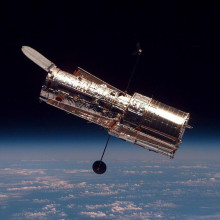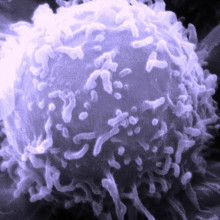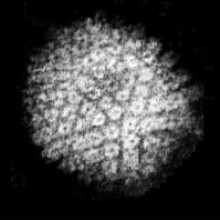Sea Sick Corals and Chronic Fatigue
This week we hear how seaweed is making coral sea-sick, how anti-virals could be used to treat Alzheimers disease, get new insight into the cause of Chronic Fatigue Syndrome and discover the possibility of water on another Solar System. Plus, how a kitchen could help you learn French, the opening of the World's first Spaceport, new hope for a Malaria vaccine and new insight into how the Giant Panda survives on a diet of Bamboo!
In this episode

00:21 - Water in Another Solar System
Water in Another Solar System
Our Solar System may not be alone in having an abundant supply of water. That's according to a paper published this week in the Journal Science. Michiel Hogerheijde and his colleagues have been using the Herschel Space Observatory to study the star TW Hydrae -- a star so young, only around 10 million years old, that it's arguably still forming, but which we expect will eventually end up at around 60% of the mass of our own Sun. TW Hydrae is a very well-studied system because it's the closest example to us of such a very young star, and of particular interest is the disk of gas and dust which surrounds it, which we expect will eventually form into a planetary system not dissimilar our own Solar System.
It's interesting to ask how similar to our Solar System that planetary system might turn out to be. One of the really important characteristics of our Solar System, certainly in terms of making life possible in it, is that it has an abundant supply of water in the form of comets. We have models for where we think that water came from in the Sun's planet-forming disk. Very close in to the Sun, in the hottest part of the disk, it would have sublimed (boiled) and been in the form of water vapour or steam. But out beyond the asteroid belt, beyond what we call the ice line, it would have been frozen into solid lumps of ice, which explains why the Solar System has rocky bodies in the asteroid belt, but icy comet-like bodies further out. Those comets played a vital role in bringing the oceans to the Earth, because the Earth formed inside the Solar System's ice line, as a dry planet: only through later bombardment of comets onto its surface did water arrive and make Earth a wet planet.
Looking at TW Hydrae from the outside, we've had no trouble in the past in detecting water vapour in its inner central regions. But detecting whether ice is present further out has proven problematic. What Michiel Hogerheijde has done in this new study is to make use of the fact that, if ice is exposed to ultraviolet light, you'd expect a tiny fraction of the water molecules to break away from the solid lumps and form very cold gaseous water vapour. In TW Hydrae, there does indeed appear to be evidence for very cold water vapour extending a long way out in the disk, where it couldn't have formed by straightforward sublimation. So, this appears to be evidence that there is a vast amount of water ice -- several thousand times the total amount in the Earth's oceans -- around TW Hydrae, and suggests that this system has the potential to form both comets, and eventually wet habitable planets like our own Earth.
detecting water vapour in its inner central regions. But detecting whether ice is present further out has proven problematic. What Michiel Hogerheijde has done in this new study is to make use of the fact that, if ice is exposed to ultraviolet light, you'd expect a tiny fraction of the water molecules to break away from the solid lumps and form very cold gaseous water vapour. In TW Hydrae, there does indeed appear to be evidence for very cold water vapour extending a long way out in the disk, where it couldn't have formed by straightforward sublimation. So, this appears to be evidence that there is a vast amount of water ice -- several thousand times the total amount in the Earth's oceans -- around TW Hydrae, and suggests that this system has the potential to form both comets, and eventually wet habitable planets like our own Earth.

03:51 - Cause of chronic fatigue?
Cause of chronic fatigue?
 A patient receiving treatment for lymphoma simultaenously recovered from chronic fatigue syndrome, revealing a novel way to combat the conditions, researchers have revealed.
A patient receiving treatment for lymphoma simultaenously recovered from chronic fatigue syndrome, revealing a novel way to combat the conditions, researchers have revealed.
Chronic fatigue syndrome (CFS), also known as ME (myalgic encephalomyelitis), is associated with a constellation of symptoms that include severe unexplained exhaustion, disturbed sleep, headaches, muscle and joint pains as well as cognitive, sensory and even bowel disturbances. The cause of the condition, however, remains unknown. But now Norwegian scientists have found evidence to suggest that the disease may have an immune cause that can be treated by temporarily removing one class of white blood cells, called B lymphocytes, from the body.
Writing in PLoS One, Haukeland University Hospital, Bergen-based researcher Olav Mella and his colleagues decribe a double-blind clinical trial in which 30 patients diagnosed with CFS were randomly assigned to receive either a B lymphocyte-depleting drug called rituximab, or a placebo. Followed up over 12 months, 67% of the patients in the rituximab arm of the trial showed significant improvements in their own as well as physician-based assessments of their condition. Only one patient in the placebo group showed similar improvements. This strongly suggests that CFS has an immunological underpinning, which fits with the onset often following an antecedent infection of some kind.
Interestingly, the rituximab-treated patients only began to show improvements in their symptoms after about 3 months. This, say the scientists, would be consistent with the time it takes for antibodies released previously into the blood by the B cells to disappear.
The trial was initiated in the first place after the researchers administered rituximab to a patient with lymphoma, a cancer of B lymphocytes. The patient was delighted when his CFS, from which he was also suffering, simultaneously regressed alongside the lymphoma. This spurred the team to set up the present trial, the results from which, they say, strongly suggest that CFS has an immune cause and "will impact future research efforts" into the condition.

07:36 - Seaweed makes coral sea-sick
Seaweed makes coral sea-sick
Seaweeds, also known as macroalgae, can unleash a chemical arsenal toxic to corals, scientists have found.
Writing in PNAS, Georgia Institute of Technology researcher Douglas Rasher and his colleagues studied the sensiti vities of 3 different coral species to 8 different types of seaweed. Bringing the two together, as might occur on a reef, resulted in bleaching, reduced photosynthesis and even death of the corals in almost 80% of cases. Physical proximity wasn't the cause, the scientists confirmed. When plastic models of the offending macroalgae were substituted for the real thing, the corals remained healthy. Instead, it turns out that the seaweeds secrete a cocktail of oil-soluble chemicals called terpenes. These can rub off on the corals, killing them.
vities of 3 different coral species to 8 different types of seaweed. Bringing the two together, as might occur on a reef, resulted in bleaching, reduced photosynthesis and even death of the corals in almost 80% of cases. Physical proximity wasn't the cause, the scientists confirmed. When plastic models of the offending macroalgae were substituted for the real thing, the corals remained healthy. Instead, it turns out that the seaweeds secrete a cocktail of oil-soluble chemicals called terpenes. These can rub off on the corals, killing them.
The seaweed most likely use the chemicals as a means of anti-microbial defense. But corals can become croppers when reefs damaged by human activities and climate change are then invaded by the macroalgae, which are able to gain a toe-hold in the first place because the ruining the reef also renders the habitat untenable for herbivorous fish that would previously have kept the weeds in check. This, say the scientists, may well explain the lack of recovery seen on many present-day reefs...

10:02 - Antiviral for Alzheimer's
Antiviral for Alzheimer's
Drugs targeting herpes simplex virus (HSV), the agent that causes cold  sores, might also abate Alzheimer's, new research has shown.
sores, might also abate Alzheimer's, new research has shown.
Previous research has tied HSV to dementing diseases like Alzheimer's since scientists showed that the DNA of the virus crops up in the brain in the same spots as the beta-amyloid plaques and neurofibrillary tangles that characterise the condition in the brain. HSV-infected neurones also make more of the enzymes and proteins that produce these pathological hallmarks of the disease. But with 80% of people testing positive for herpes simplex infection, it was unclear what, if anything, doctors could do to reduce the risk of Alzheimer's, which currently afflicts about 18 million sufferers worldwide.
Now, Manchester University scientist Ruth Itzhaki has shown that treatment with the safe antiviral agent aciclovir can, in the dish at least, reduce the rate of beta-amyloid formation, thereby mitigating the risk of Alzheimer's. By using a variety of mutant viruses lacking key genes, Itzhaki and her colleagues were able to interrupt the growth of the virus at different stages of its infectious cycle to discover what aspects of viral replication might increase beta-amyloid production. DNA synthesis - when the virus copies its DNA code - they found, appears to be the critical step. Luckily this is the very stage that is targeted by anti-herpes drugs like aciclovir and, sure enough, treating the cells with this agent reduced the rate of production of the tangle-forming proteins and, indirectly, beta-amyloid also.
The results are based only on an in-vitro study, but suggest, given the safety and relative low cost of aciclovir, that a clinical trial is warranted to explore whether antivirals can cut dementia rates in the elderly. As the scientists themselves point out, although a high fraction of the population carry HSV infection for life, in the majority the virus remains in the peripheral nervous system. It's chiefly in the elderly that the virus appears to invade the brain. Therefore, antiviral agents could arrest this process and reduce the risk of progression to Alzheimer's.

20:17 - Spaceports, IVF and Malaria Vaccines
Spaceports, IVF and Malaria Vaccines
Richard Branson, Virgin; Dagan Wells, University of Oxford; Tsiri Abunyega, Malaria Vaccine Initiative; Fuwen Wei, Chinese Academy of Sciences
Virgin Galactic Spaceport
The World's first commercial spaceport has opened in the deserts of New Mexico.
Mexico.
Targeting all budding astronauts, Spaceport America is Virgin Galactics gateway to space providing members of the public five minutes of weightlessness at a cost of £127,000.
The eco-designed building will house seven spaceships, mission control and a visitor experience area for those that can't afford the flight itself.
Sir Richard Branson spoke at the launch.
Richard - These beautiful ships will shortly be ready to welcome the first of more than 450 people paid up and waiting to fly. The building has achieved the lead gold standard using local materials and regional construction techniques and we have minimised energy requirements through the use of geothermal heating and cooling, and extensive energy management practices. Simply put, it's a 21st century building for a 21st century business.
---
Improving the Success of IVF
 A new test could significantly boost the success of IVF treatment.
A new test could significantly boost the success of IVF treatment.
The technique developed by Dagan Wells and his team at the University of Oxford screens potential embryos for genetic and chromosomal abnormalities before they're implanted, improving chances of pregnancy by up to 70%.
Currently in the UK and many other countries globally, the healthy appearance of an embryo is enough for it to be used in a cycle.
Dagan - The embryo that looks the best can often harbour lethal genetic abnormalities. So the new test really combines a bunch of different aspects of embryo biology assessment, so we're looking at the chromosomes, we're looking at the mitochondria which power the cell, we're looking at the telomeres which protect the chromosomes. And together, that's giving us a very deep insight into the health and biology of the embryo.
---
Malaria Vaccine Trial
A Malaria vaccine could be on the horizon after promising results from a clinical trial taking place across Africa.
The RTS,S Malaria vaccine is the most advanced Malaria vaccine to date, currently targeting children under 18 months of age. Involving over 15,000 participants across seven African countries, preliminary results from the Phase III clinical trials found infants aged 5 to 17 months receiving the vaccine had about half the risk of developing Malaria than those without it.
Tsiri Abenyega is principle investigator on the trial site in Ghana.
Tsiri - Our results showed that RTS,S reduced the risk of children aged 5 to 17 months, experiencing clinical Malaria by 56% over a 12-month follow up period. The study also found that RTS,S reduced the risk of severe Malaria by 47%. This is remarkable when you consider that there has never been a successful vaccine against a human parasite.
---
Life on a Bamboo Diet
 And finally, new insight into the eating habits of the Giant Panda.
And finally, new insight into the eating habits of the Giant Panda.
Unlike other meat-eating bears, the giant panda is an omnivore with a diet consisting mainly of bamboo - eating up to 12kg of the plant every day. But their ability to digest the cellulose and hemicellulose fibres dominating a bamboo plant has long been a mystery as they lack the digestive enzyme usually found in other herbivores.
Using gene sequencing techniques, Fuwen Wei and his team from the Chinese Academy of Sciences identified unique enzymes and bacteria helping Pandas make a meal of this low nutrient plant.
Fuwen - We found in the panda some special bacteria that could help the pandas digest the fibre. Also, we found some genes coding for enzymes to do this kind of job. But the nutrition is very low, they content, low protein, sugar and fat. So the panda needs to get some part of its nutrients from the fibres.
Despite having these methods of digestion, the bamboo remains low in nutrition explaining just why the Pandas have to eat such large quantities of the bamboo on a daily basis. However the reason they choose to eat this above other foods remains a mystery.










Comments
Add a comment